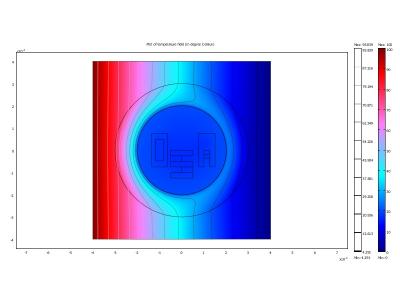A team of French researchers has devised a new approach for cloaking or isolating objects from heat sources known as ‘thermal cloaking’. The researchers have presented this approach in the Optical Society's (OSA) open-access journal, Optics Express.
 This figure shows that the object in the center of the cloak (letters OSA) stays cold, while the heat diffuses elsewhere. The source of the heat is on the left-hand side and at a constant temperature of 100°C, and the material inside the invisibility region remains cold. Credit: Image courtesy Sebastien Guenneau, Institut Fresnel, CNRS/AMU
This figure shows that the object in the center of the cloak (letters OSA) stays cold, while the heat diffuses elsewhere. The source of the heat is on the left-hand side and at a constant temperature of 100°C, and the material inside the invisibility region remains cold. Credit: Image courtesy Sebastien Guenneau, Institut Fresnel, CNRS/AMU
The physics of transformation optics forms the basis of the latest developments in invisibility cloaks. Here, metamaterials and bending light are being propagated around a space and not through it. Along with CRNS colleagues, Sebastien Guenneau conducted studies on thermal diffusion and found that the physical phenomenon involved in cloaking research is diffusion, rather than wave propagation.
Guenneau and colleagues creating their thermal invisibility cloak by using the mathematics of transformation optics to equations for thermal diffusion.
According to the researchers’ two-dimensional approach, the flow of heat is from a hot to a cool object with the heat flux magnitude present across any region in space, and this is denoted by the distance between isotherms i.e., concentric rings of diffusivity. The isothermal geometry was altered to determine that any object placed in the isothermal region can be protected from the flow of heat.
Majority of applications entail thermal protection. Hence the capability to protect an area from heat or heat concentration is of much use in various applications. The electronics and semiconductor industries face difficulty in shielding nanoelectronic and microelectronic devices from heat. On a wider scale, this thermal approach may be implemented in large computers and spacecrafts in the future.
Guenneau and colleagues are currently developing prototypes of thermal cloaks for microelectronics, which will be available in a few months.